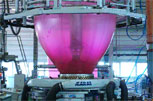Crude oil as source material
Basic material for the film production is crude oil. From this, through the fractionated
destillation of the raw fuel, the so-called �Naphtha� can be achieved. Through strong heating of the Naphtha (�Cracken�) the gaseous ethylene will be released.
This actual �by-product� was burnt down in previous times, until its real value
as raw material was identified.
Due to the so-called polymerisation, polyethylene is produced from the ethylene gas which is by far the most produced synthetic material world-wide and amongst others serves as the raw material for the film production.
One differentiates here between the high pressure procedure, whereby PE with low density and the low pressure procedure, whereby high density occurs. Depending on the procedure and the resulting density and flow ability therefrom, polyethylene shows that it has different characteristics regarding its composition (stiffness / elasticity). Main types of polyethylene are LDPE, HDPE and LLDPE to name a few. The latter can be, when required, mixed with the others, due to its structure which is a very soft material.
The synthetic material will already be given by manufacture the necessary characteristics, that is later for a specific application (e.g. film).
The gas will be transformed at high temperatures and under pressure into a tough fluid state of aggregation.
After the gas has been put into a fluid form, it is pressed through a sieve, so that the polyethylene slowly solidifies and can escape in the form of strands on the other side.
A rotary knife makes sure that the strands will be cut into small pieces, resp. grains.
This granulate forms in turn the source material for further production.
The granulate becomes film
Synthetic materials are mainly manufactured in so-called extrusion-production today.
Thereby, the synthetic granulate will be constantly filled into an extruder.
This can be compared to a mincer e.g. according to its functionality. The granulate will be put into the extruder by means of a rotary �snail� through a heated metal pipe and re-liquidated.
In this connection, the necessary additives for the film, such as e.g. antiseize or static inhibitor, as well as colour batches will be added when required via mixing stations.
Thereafter, hence the granulate once again has got its entire fluid state of aggregation, the melted mass will be lead by means of pressure through the openings (nozzles) of the extruder and blown with air to a film tube to the desired strength and specified circumference.
Should the film be provided with a printed image at a later stage, it will be necessary, that after the cooling down of the tube the surface tension of the film will additionally be raised (Corona pressure pre-treatment), in order to warrant, that the corresponding printed image can later be tightly joined to the film.
The tube is led over a rolling machine, when required cut with knives (e.g. Flat film, half-tubular film), laid flat and finally wound around sleeves.
The film can be printed and rewound in a further production step on modern flexo- printing machines in up to 6 colours, if desired.
Furthermore the tubular film is passed through, on demand of the make, that means that the tubular film will be brought into the desired form, in this production step, to the customer�s specifications, e.g. to loose sacks welded-off, resp. provided with tear-off perforation.
Film as a flexible packaging form
As already mentioned, film made from polyethylene nowadays does not bear thinking about being without, it is utterly indispensable.
At present, it is not foreseeable, that an alternative material with regard to the film can be made satisfactory to the contrived requirements of the packaging form.
With regard to its multiple application possibilities, synthetic film can secure its previous supremacy in the packaging area and moreover expand it.
Synthetic materials are mainly manufactured in so-called extrusion-production today. Thereby, the synthetic granulate will be constantly filled into an extruder.
This can be compared to a mincer e.g. according to its functionality. The granulate will be put into the extruder by means of a rotary �snail� through a heated metal pipe and re-liquidated.
In this connection, the necessary additives for the film, such as e.g. antiseize or static inhibitor, as well as colour batches will be added when required via mixing stations.
Thereafter, hence the granulate once again has got its entire fluid state of aggregation, the melted mass will be lead by means of pressure through the openings (nozzles) of the extruder and blown with air to a film tube to the desired strength and specified circumference.
Should the film be provided with a printed image at a later stage, it will be necessary, that after the cooling down of the tube the surface tension of the film will additionally be raised (Corona pressure pre-treatment), in order to warrant, that the corresponding printed image can later be tightly joined to the film.
The tube is led over a rolling machine, when required cut with knives (e.g. Flat film, half-tubular film), laid flat and finally wound around sleeves.
The film can be printed and rewound in a further production step on modern flexo- printing machines in up to 6 colours, if desired.
Furthermore the tubular film is passed through, on demand of the make, that means that the tubular film will be brought into the desired form, in this production step, to the customer�s specifications, e.g. to loose sacks welded-off, resp. provided with tear-off perforation.
As already mentioned, film made from polyethylene nowadays does not bear thinking about being without, it is utterly indispensable.
At present, it is not foreseeable, that an alternative material with regard to the film can be made satisfactory to the contrived requirements of the packaging form.
With regard to its multiple application possibilities, synthetic film can secure its previous supremacy in the packaging area and moreover expand it.
 Production process
Production process



